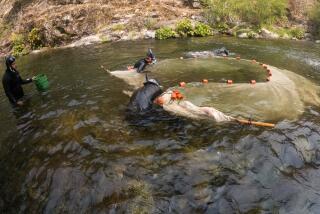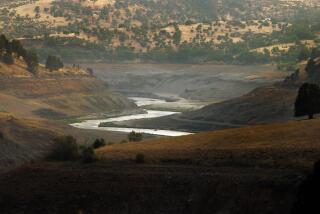Fighting Drought With Tradition
- Share via
CASCABEL, Ariz. — As monuments go, Barbara Clark’s desert dams are so innocuous that even she has trouble finding them.
“Where the heck are you?” she hollers into the mesquite as her pickup truck bucks up the parched stream bed of the ephemeral Rio San Pedro.
Steering with her knees, Clark ignores the brambles lashing the windshield and deftly rolls a cigarette from a gallon plastic bag of tobacco jiggling on her lap.
She’s far from lost. There’s only one way in and out of this remote, wild crease in the Santa Catalina Mountains, located two hours east of Tucson’s lush green golf courses and sprawling suburbs. Fifty miles from the border, it’s a place where American Top 40 and Mexican salsa radio collides and dissolves in a cloud of static.
“They’re just little, little piles of rocks,” Clark explains, craning her neck through a cloud of smoke. “We do the best with what we’ve got out here.”
And rocks are about all that’s left. With them, Clark aims to slow precious flood water and break the grip of a harsh drought before it wrings the last gasp from a slice of the Sonora Desert that has been grazed, smelted, eroded, irrigated and developed since the Spanish conquistador Coronado launched his quest for Eldorado up this same dry wash in 1539.
Many water utilities and corporate farmers from California to Florida have responded to the crisis by pumping more of their stored water from reservoirs and aquifers.
But Clark, a 50-year-old potter and self-described hippie homesteader, is trying to meld the simple technologies of ancient Indian watercourses with ‘60s-style community activism.
Over the last three years, she has organized valley neighbors, volunteers and hired hands to assemble 5,200 tiny loose-rock dams at key junctures around a 10,000-acre parcel in the San Pedro watershed.
The dams’ function is not to impound water, but to slow its downhill dash and encourage more of it to seep into the earth.
And just in time. Conditions are the driest in the 30 years Clark has been living along the San Pedro.
The dams are assembled according to a design developed by the Hohokam, pueblo Indians who first farmed this wash 1,000 years ago. Two dozen stones nestle in the shape of an arrowhead across a narrow gulch.
Although the design is native in origin, Clark uses the same vocabulary as the engineers who dammed the West’s great rivers with concrete and steel.
Straddling the ditch, Clark tosses back her long, gray braid and undertakes a few simple repairs.
In the center of the channel she places the keystone, a rock the size of a basketball. Then she surrounds it with riprap, or smaller rubble. The structure forms a small V.
Runoff is channeled over the center of the dam, or the spillway. It flows gently downhill across the dam’s apron.
With her skilled potter’s hands, Clark snuggles the rocks close to avoid creating sharp angles that will only agitate the water or, worse, create a waterfall and encourage more erosion.
Do her dams work? Clark answers with a shrug. “You can build all the dams in the world, but if you don’t incorporate them into the landscape, it’ll just lead to more erosion,” Clark said. “Over the next 10 years, we’ll see if these little guys do any good.”
More to Read
Sign up for Essential California
The most important California stories and recommendations in your inbox every morning.
You may occasionally receive promotional content from the Los Angeles Times.













